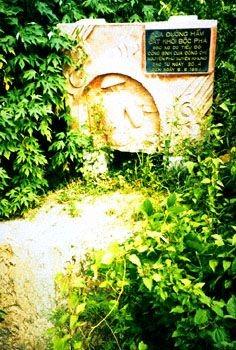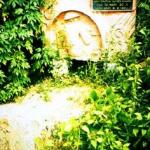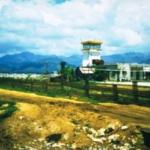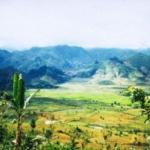A Journey to Dien Bien Phu
"Bonjour, Monsieur." Stepping across the threshold of Voi Phuc Temple, the elderly man's narrow face brightened into an animated smile. He pauses near the alcove housing the White Horse statue, expectantly awaiting my reply. I'm not sure what to say. Although I'm not French, I have come to the edge of Hanoi's Thu Le Lake to visit this temple because the French were here. Before liberation, the colonialists called the Temple of the Kneeling Elephants "Balney Pagoda" after the young lieutenant who fell somewhere along its esplanade. "Je regrette, Monsieur. Mon Français . . . c'est pauvre." The old man's eyes sparkled; his sparse chin whiskers touch his chest as he slowly nods his head. "Parlez-vous anglais, Monsieur? I speak English." Professor Nguyen Van Huyen, Ph.D. extends his hand to me. "So do I. Cambridge University, 1937."
For the next several hours and on quite a few days afterward, it was my good fortune and privilege to share a few spring afternoons with the multilingual and utterly charming retired professor. When I told him that I had traveled to Vietnam with the express purpose of visiting Dien Bien Phu, and would leave for the northwest in a few days, his whole manner'that of a tweedy academic, frail in old age'underwent a transformation before my eyes. His shoulders straightened; his bearing became that of a much younger man. His voice, when he said, "I was there," took on a tone that was filled with pride.
Professor Nguyen was kind enough to tell me many things about the winter-spring campaign of 1953-1954 and he even offered, with great enthusiasm, to be my guide to the battlefield. If I have one regret concerning all the time that I have spent in Vietnam, it was my failure to accept Professor Nguyen's gracious offer.
Flights are available to Dien Bien Phu, but I wanted to go overland. I knew the roads would be tough on my constitution, let alone on that of a man in his eighties. When winter came, Professor Nguyen passed on, and I think now that such a visit'a return to the scene of his nation's and his own youthful triumph'would not have seriously lessened his days. I know mine would have been enriched.
Beatrice, Gabrielle, Anne-Marie, Huguette, Claudine, Dominique, Eliane, and lonely Isabelle. These pretty French names, briefly given to the Lai Chau Province hills that dot the valley, are what the foreign tourists come to see. If one has flown up from Ho Chi Minh City, or Hue, or four-wheeled from Hanoi, you've walked on a broad thoroughfare running through each of these cities that bears the name Dien Bien Phu. You should know then, that to the people of Vietnam, these hills mean a great deal.
The roads rising from the delta of the Red River to the hairpin curves of the Pha Din Pass are all I expected them to be, and more. Although Dien Bien Phu is only 260 miles northwest of Hanoi, the drive takes two long, bumpy days to complete. If you rent a modern 4-wheel-drive for your journey it may take a few hours less and be more comfortable, but I am happily carried through the mountains in Mr. Ta's rugged, but trustworthy, Russian jeep. Mr. Ta is good at what he does; he is welcome in the homes of many of the minority people who populate the highlands of northern Vietnam. Their hospitality and the warm cups of yellow tea they offer are most welcome when we stop to stretch our legs. Near Co Noi, I am even given the opportunity to target shoot with one of our hosts' crossbows.
From the great dam at Hoa Binh to the chalky heights of the plateau, many of the hillsides we pass have been stripped of their oak and soft pine forests. People tend to congregate along the power lines running north from the dam. It is my understanding that reforestation efforts are now underway, and I hope that on my next visit these hills will once again display their noble green mantles.
Driving on, the valley and hillside villages dwindle. The mountains here look as they must have looked forever. Extending as far as the eye can see, green rounded slopes rise to a series of magenta peaks that seem to touch the clouds. Late in the afternoon of the first day, we emerge from the mountains onto the broad plain of Son La. Our arrival at the Hoa Ban Hotel in Son La Town receives a greeting that I had not at all expected. A half-dozen young women, dressed formally in beautiful red ao dais, step onto the hotel's verandah as our dusty vehicle pulls to a stop. Each of the women carries a bouquet of flowers, which they offer to me as I climb from the jeep. The head of this welcoming delegation is the resident physician at Son La Hospital; she is wearing a white ao dai, beautifully embroidered down the front with delicate blue flowers.
It seems we have arrived at the same time a group of Australian doctors working under UNICEF auspices are expected. Mr. Ta straightens out the misunderstanding; the women step back into the hotel with their bouquets. I am not too disappointed to find out that the flowers are not for me. Hard-pressed to find a place for me because of the Australians, the Director of the Hoa Ban is a more than accommodating host and offered me the comfort of his own room for the night.
Early in the morning, before the now properly welcomed UNICEF physicians are awake, Mr. Ta and I are on our way. From Son La Town up to Pha Din Pass the high mountain vistas hold some of the most beautiful scenery in the world. Mr. Ta pulls over periodically so I can snap a few photographs of the breathtaking views. Sometimes, all I can do is stand and stare.
Far below us the valleys shine as squared gems of paddy, the dark outline of their water wheels black specks against emerald fields. Fissured hills, tufted darker green, hem in the narrow valleys, fronting the great mountains of the Ma River range.
Late in the day and weary from the jolts in the road, we arrive in Dien Bien Town. A steady stream of trucks rolling along the town's main street, coming from and going to the Laotian border -- barely thirteen miles to the west -- underscores the constant building activity that has transformed what was once a sleepy Black Thai village into a bustling crossroads town. Wearing shining marbled facades, several modern hotels line Main Street. Ours is just fine, but when tropical night comes, swift and gentle, I find sleeping a difficult proposition.
Awakened the next morning by the comforting croak of a gecko on mosquito patrol, I'm eager to make my first stop at the History Museum of the Dien Bien Phu Victory. The museum's centerpiece is an electronic diorama that chronicles the events of the siege that ended the 1946-54 Resistance War. As noted, my French is poor, but it seems fitting that I listen to the display's recorded narration in the sibilant French available on the recorded track. I know the story and can easily follow the tiny strings of green and red lights tracing the flow of the battle.
Late in 1953, General Henri Navarre, Commander-in-Chief of the French effort, ordered fifteen thousand men of the Corps Expeditionnaire Francais d'Extreme-Orient to the Muong Thanh valley. Airlifted, the army fortified the valley hills with barbed wire, trenches, cannons and mine fields. Navarre was confident that the People's Liberation Army could not haul their artillery to the mountains above the basin without falling prey to his roving air force. He was confident that even if cannons did get through, they, and the divisions that accompanied them, would never be supplied with an adequate amount of food and munitions. He was wrong.
Hills Beatrice and Gabrielle, or, as they are known here, Him Lam and Doc Lap, fell early to the Peoples Liberation Army, but at great cost. Anne-Marie (Ban Keo) fell with fewer losses. For the next two months, the Peoples Army dug their way through the tangles of wire shielding the Central Subsector on the basin floor and the hills commanding the eastern side of the valley. One summit on the eastern hills is portrayed on the three-dimensional scene with the laconic designation "A2" -- a designation that cannot begin to describe the desperate struggle waged there between the two opposing armies up until the very end, May 7, 1954. The rest of the museum holds exhibits of battlefield artifacts: rifles, machine guns, helmets and mortars. The dappled camouflage of the French paratroopers is here, and the now faded green uniforms of the Vietnamese.
One exhibit displays a heavily laden bicycle, a truck tire studded with nuts and bolts, a crude wooden sledge, several baskets and a Nghe An barrow. Perhaps it was the mortars and guns that brought the Corps Expeditionnaire to their knees after fifty-five days of unending battle, but when you look at the bicycle, the baskets and the barrow, you will be looking at the weapons that won the war. More than fifty thousand men, women and children used these household weapons to carry supplies and munitions to the combatants at Dien Bien Phu. Without their sacrifice on the roads that they carved themselves across hundreds of miles of mountains, rivers and jungle, the French flag might still be flying over the Theatre Municipal in downtown Hanoi.
After posing for a group photograph with the museum staff, we go out to the yard where a display of ruined ordnance bears mute testimony to the ferocity of the conflict. A stark granite obelisk standing in front of the twisted metal commemorates the sacrifice of the Vietnamese. Walking along the path to the street, I suddenly find myself engulfed in a wave of preschool children coming into the sun for their morning recess. With gleeful laughter and shrill cries of delight, they surround me. Within seconds, I have a beautiful, dark-haired child clinging to each one of my fingers. I think no better testament could mark the ultimate sacrifice of the rows and rows of honored dead who are buried in the somber military cemetery just across the way than these happy children growing up proud and free in the shadow of the hills that helped make them so.
The dark-green hump of Eliane rises just beyond the military cemetery. Eliane holds more monuments and the rusted hulk of a tank called "Bazeilles." A premonition by its crew maybe, Bazeilles is the small French village where an encircled infantry unit fought to their last cartridge during the Franco-Prussian war. The basement foundations of the former Resident Superieure's villa, which served as a battalion command post, are here too. Dark and shrouded with weeds, you need a flashlight to examine its forbidding interior. Moving away from the bunker, you come to a wide, overgrown depression in the ground. On the last night of battle a great mine was touched off here and the "Capital Regiment" of the Peoples Army charged one more time against Eliane's stubborn French defenders. Joined by Miss Lien, our guide from the museum, we spent several hours on Eliane and the close-by Dominique. Beneath a cover of low grass the ground here is uneven, churned up by the thousands of high explosive shells that rained down on the eastern hills. Bits of rusted casings poke through the earth's crust. We step carefully to avoid them. All over the valley fighting was fierce, but here, on Eliane, it was very intense. As we walk and look under a warming sun the earth itself seems to be telling me that this is fought-for ground, that men struggled and died here.
Nights in Dien Bien Town are peaceful with only the calls of cicadas, bullfrogs and geckoes breaking the quiet. Rustic in amenities perhaps, there are a number of restaurants serving reasonably priced, delicious meals. In a small cafe formed by walls of woven matting, I prevail on Mr. Ta to pick up the microphone of the ubiquitous karaoke machine. One or two cans of Tiger beer overcome his initial shyness; he sings a ballad in a surprisingly rich voice. I try to decline my turn, but the few patrons in the cafe are politely insistent. They try not to laugh too much at my mangled pronunciations of the words rolling across the TV screen, applauding my red-faced effort when the video gratefully ends.
Little remains of the Central Subsector'the site of valley Commandant General de Castries' headquarters'and the earthworks that made up bastions Anne-Marie, Huguette, and Claudine. Rice grows here now. You can wander inside the preserved remains of de Castries' bunker, for it is still here, much as it was five decades ago. Looking to the north, I see the long outline of Gabrielle Hill set against the formidable mass of Pha Son. Somewhere on that mountain, General Vo Nguyen Giap directed his forces from the rude shelter of a limestone cave.
I want to see the site of the Corps Expeditionnaire hospital, for I confess to harboring a romantic spot in my heart for Genevieve de Gallard-Tarraubes, the flight nurse who became the only European woman to share the rigors of the siege. Ms. Lien tells me the white obelisk dedicated to the fallen French soldiers marks the site of the hospital's underground caverns. I think it was a little further north, near the bend in the shallow Nam Rom River, but rivers change their course sometimes, during the monsoon. It doesn't really matter. She was here.
The Dien Bien Airport is exactly where the French Aerodrome was once laid out on a sea of pierced steel plating; the plating is here still, only now it forms a rust-colored fence enclosing the modern control tower and cement runway. Climbing the red earth of Gabrielle Hill, I find that it, too, is littered with bits of rusted metal; we continue to step very carefully.
The Vietnamese name for Gabrielle Hill (Doc Lap) means freedom. When you arrive at the small monument dedicated to Phan Dinh Giot, you will easily understand why. During the assault his unit was pinned down by fire from a machine gun bunker. In order to shield his men, Phan threw his own body across the bunker's slit opening. Hero is a word whose currency may be somewhat cheapened these days through overuse. On Gabrielle Hill, heroes were many.
We spent several more days in the valley and in the surrounding mountains. We climb the gentle slopes of Beatrice and drive down to the southern end of the valley, visiting Isabelle Hill. In between rounded foxholes and half-filled trenches, a grove of spindly fruit trees struggles to turn the scarred slopes of the last hill to fall into a garden. In the valley and hillside villages of the Tay Dam people, many of the adult residents have vivid memories of the day the parachutes blossomed in the skies; they remember the clash of the armies.
In a stilted house rising over a yard rich with grains of drying rice, I am welcomed to observe a mother and daughter working diligently over the warp and weft of their foot-powered loom. Dressed in long dark skirts, elegant blouses fastened with silver beehive clasps and beautifully embroidered headdresses, they are a bit shy. After purchasing several lengths of their exquisite weaving and talking quietly over cups of bitter tea, Mr. Ta tells me that it is time to go and that the ride to Cao Bang will be a lot easier. Should I wish to go along the old Route 4, we can even swing by the Ba Be Lakes on our way back. I was not about to decline any more offers. I know there is always something more to see, and everything to learn, all across the northern provinces of Vietnam.
Suggested Reading:
Gen. Vo Nguyen Giap, Dien Bien Phu, Hanoi, The Gioi Publishers, 1994 English translation.
Bernard B. Fall Hell in a Very Small Place: The Siege of Dien Bien Phu, New York, Da Capo Press, 1992.
Mr. Ta's services may be procured through Hoa Long Tourist Co. Ltd. at the Win Hotel, Hanoi.
Originally published: May 1, 1998.
 ThingsAsian
ThingsAsian
















